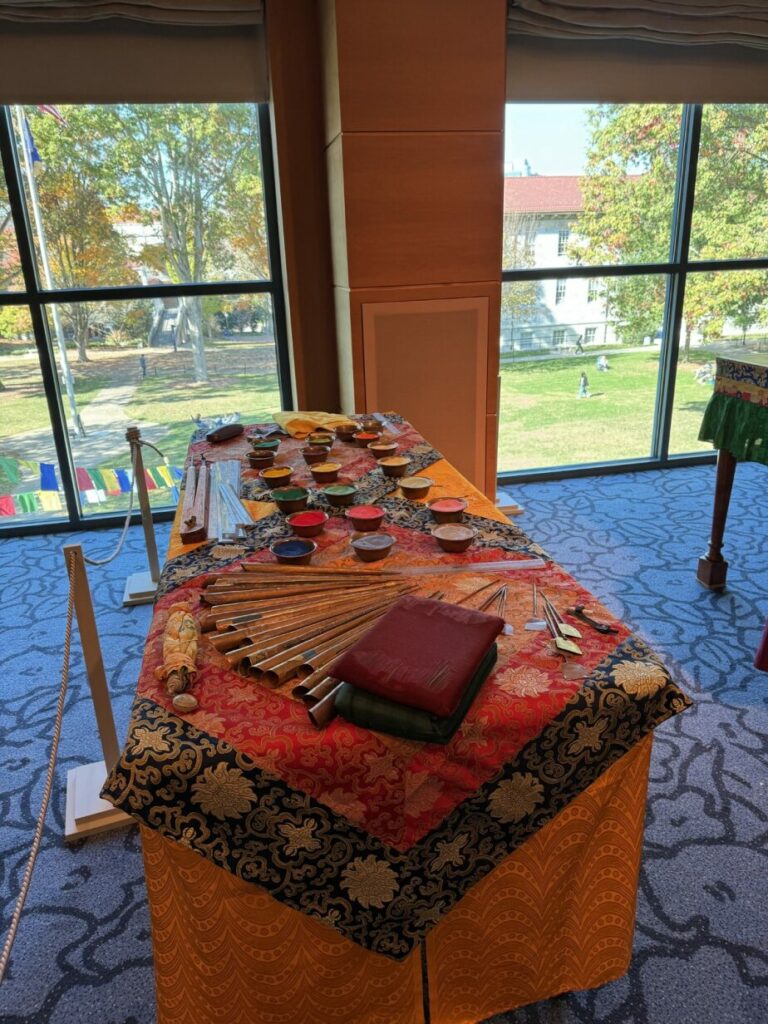 (Lauren Katz/Contributing Writer)
(Lauren Katz/Contributing Writer)
Tibet Week returned to Emory University for another year of connections, ceremony and celebration. The week of events, which took place from Nov. 6 to Nov. 11, held special significance as it marked the 25-year anniversary of Emory’s partnership with His Holiness the Dalai Lama and the Drepung Loseling Monastery. The theme for this year’s Tibet Week celebration was “Compassion in Action.” The series of events took place in Ackerman Hall on the top floor of the Michael C. Carlos Museum.
The week began on Nov. 6 with the renewal of the partnership between Emory and the Drepung Loseling Monastery. The renewal ensured the continuation of the Center for Contemplative Science and Compassion-Based Ethics, informally referred to as the “Compassion Center.” Shortly after, the Tibet Week opening ceremony marked the start of the week of celebration. Monks from the Drepung Loseling Monastery began with traditional Tibetan music and chants on Emory’s Atlanta campus Quadrangle before moving into the Carlos Museum.
 (Lauren Katz/Contributing Writer)
(Lauren Katz/Contributing Writer)
The Compassion Center combines ancient Tibetan Buddhist wisdom with modern scientific knowledge to spread the teachings on a global scale. The program seeks to bring His Holiness the Dalai Lama’s call for a “compassion revolution” to the world through the combination of science and spirituality. The Compassion Center’s Cognitively Based Compassion Training program (CBCT) is one of the ways the center contributes to this movement. CBCT Senior Program Coordinator and Planning co-Chair for Tibet Week, Hannah Smith (15Ox, 17C), reflected on the teachings of compassion that have flourished during the partnership.
“We’re in a mental health crisis, especially after the pandemic,” Smith said. “You can cultivate [the ability] to practice self-compassion, promote resilience, extend compassion to others through using some of these skills.”
Smith also stressed the importance of introducing Buddhist wisdom to more places in the future.
“Bringing those into a Western context is really valuable,” Smith said. “And that’s why this exchange is so beneficial, not just here, but around the world.”
The Compassion Center houses three primary programs: Social, Emotional, and Ethical Learning (SEE Learning), CBCT and the Emory-Tibet Science Initiative (ETSI).
“They’re all built around exchanging knowledge and perspectives, cross-culturally, between Emory and the academic, contemporary science world that it represents, and the Indo-Tibetan Buddhist tradition,” said Timothy Harrison, the CBCT program’s associate director.
 (Lauren Katz/Contributing Writer)
(Lauren Katz/Contributing Writer)
After the opening ceremony, the monks began to create a sand mandala of an enlightened female Buddha, Green Tara. They constructed the sand mandala, an act of healing and purification in Tibetan culture, over the course of the week in order for it to be completed before the Tibet Week closing ceremony.
Throughout the week, event-goers could watch the monks construct the sand mandala at its various stages and visit the surrounding exhibit on the history of Tibet in Ackerman Hall.
During Tibet Week, the Carlos Museum hosted daily compassion meditation sessions, nightly discussion panels and talks, like the CuriosiTEA session where Tibetan artist Buchang Nugbya discussed the restoration of traditional Tibetan thangka paintings with Emory conservation fellow Ella Andrews.
Smith reflected on the importance of celebrating Tibet Week each year.
“That’s one of the goals of Tibet Week for me is showing people the very beautiful and rich culture of Tibet and the Tibetan people and Tibetan Buddhism in an effort to preserve it,” Smith said.
Additionally, the ETSI branch of the Compassionate Center program leads the Tenzin Gyatso Science Scholars Program. This program selects a cohort of six monastics from Tibetan monasteries and nunneries in India to take part in a two-year science-intensive study at Emory. Upon the completion of the residency, the monastics return to their home institutions to serve as teachers of Western science.
Rinchen Lham, one of the Tenzin Gyatso Science scholars, spoke to the significance of the program.
“It’s very important for us because it’s a vision of His Holiness to bring science and religion together, and also to have a compressed, comprehensive, a modern science curriculum, to the monastic monks and nuns,” Lham said. “It’s bridging tools to benefit us both.”
In addition to serving as students, the scholars also serve as ETSI liaisons. The liaisons work with Emory professors and students who spend a semester abroad at Tibetan monasteries in India.
The celebration of the partnership program’s silver jubilee brought both recognition of the achievements the partnership has made in the past 25 years, but also a hopeful look to the future.
“It was just very momentous for us because it marked the 25 years and kind of symbolically implied that there would be another 25,” Smith said.
At the Closing Ceremony on Nov. 11, the completed sand mandala was deconstructed. Traditionally, the sand is released into a large body of water in order to disperse it all around the world. The purpose of deconstructing the sand mandala comes from the Buddhist philosophy’s acknowledgement of the constant change in the world and the impermanence of life, according to a poster at the exhibit. Sticking with tradition, in this year’s Tibet Week Closing Ceremony, monks offered small bags of sand for the attendees to spread as a blessing to a space of their choosing.
After the closing ceremony, Lham reflected on her first time celebrating Emory’s Tibet Week, and the renewal of the partnership between Emory and the Drepung Loseling Monastery.
“I’m very happy, and I feel very fortunate to be a part of this,” Lham said.








